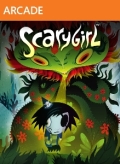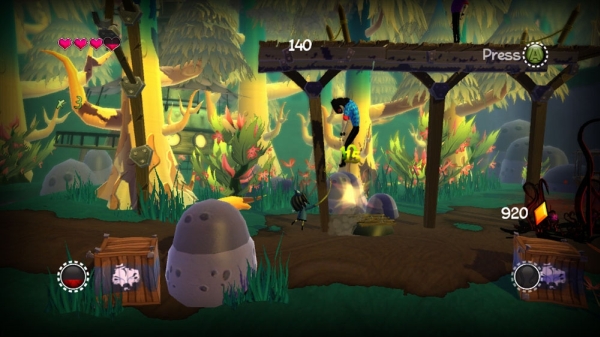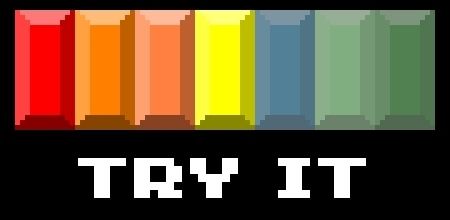
The undead have become a very popular go-to target in media lately, and it seems like every game, movie, and kids’ birthday party has at least one. Luckily, creative minds sometimes venture outside the box, or at least open the box and take a peek out. That’s sort of the theme of the graphic novel that Tik Games has shaped into their latest platformer, Scarygirl. This game blends a pseudo-2D/3D platformer feel with a bit of a hack and slash vibe to stitch together a copy of Frankenstein’s monster that is not unlike a mix between the older Teenage Mutant Ninja Turtle arcade games and LittleBigPlanet.
Platforms: PS3, Xbox 360 (Version Played)
Publisher: Square Enix
Developer: Tik Games
Genre: Harsh, Loosely-Stitched Platforming
Release Date: January 18, 2012 (XBLA), January 24, 2012 (PSN)
ESRB Rating: Everyone
 Scarygirl, which is based on an award-winning comic by Nathan Jurevicius, begins by explaining the friendship between the vaguely zombified main character and Blister – a giant blue octopus with a teensy mustache. Scarygirl becomes a victim of haunting nightmares and pursues these dreams in order to discover their meaning, since Blister apparently isn’t any help in deciphering these dreams. Okay, so it’s a platformer – many games in the genre prove that you don’t need a complicated story to create an engaging atmosphere. They rely heavily on gameplay to fill the void, and this case is no different. The game is comprised of seven worlds, each containing three stages. Upon starting the game, the player is brought through a few brief tutorials in order to get a feel for the controls. These controls don’t require much instruction, however; they’re actually quite intuitive. The player can jump, roll, block, and attack lightly or heavily with Scarygirl’s tentacle arm. There are a few preset combinations of light and heavy attacks used in order to accomplish special moves, but this is a game where these combos are easily forgettable and rarely used. Regardless, the first two worlds were fantastically made, and were a blast to play through.
Scarygirl, which is based on an award-winning comic by Nathan Jurevicius, begins by explaining the friendship between the vaguely zombified main character and Blister – a giant blue octopus with a teensy mustache. Scarygirl becomes a victim of haunting nightmares and pursues these dreams in order to discover their meaning, since Blister apparently isn’t any help in deciphering these dreams. Okay, so it’s a platformer – many games in the genre prove that you don’t need a complicated story to create an engaging atmosphere. They rely heavily on gameplay to fill the void, and this case is no different. The game is comprised of seven worlds, each containing three stages. Upon starting the game, the player is brought through a few brief tutorials in order to get a feel for the controls. These controls don’t require much instruction, however; they’re actually quite intuitive. The player can jump, roll, block, and attack lightly or heavily with Scarygirl’s tentacle arm. There are a few preset combinations of light and heavy attacks used in order to accomplish special moves, but this is a game where these combos are easily forgettable and rarely used. Regardless, the first two worlds were fantastically made, and were a blast to play through.
While the player collects gems as the game’s currency, they can purchase new special attacks, which inevitably give you additions to said forgettable button combinations. Only one of these special attacks proved useful to me; most of them did not seem to do considerably more damage than attacking normally. These special attacks can be purchased at vendors who are randomly scattered throughout the stages. They also sell attachments for Scarygirl’s tentacle arm, and collectible enemy vinyl toys are available to buy after defeating the first of each type of enemy. Other NPCs who are scattered around offer to “completely replenish” Scarygirl’s health when she pays them in gems, but every time I took advantage of this, her health meter only filled up roughly 75%. I don’t know if there’s an unexplained rule about this, or if this is a glitch, but I never received the security of being fully healed. In fact, health is rarely found in most levels, making it very tough to complete a level without dying any less than ten times.
After the first few worlds, I decided to try a little couch co-op with a friend, who took the role of the second player – a psychic rabbit who is vaguely important to the game’s minimal story. Instantly, it was noticeable that the rabbit had nothing to offer whatsoever. He could attack, jump and hover around for a couple seconds, but mostly, he could die – and he died well. He died quite a bit, actually. I’ll refer to Tails, from Sonic the Hedgehog 2. “Why can’t I do anything cool like you can?” asked my friend. “It seems like all I’m doing is hovering and dying as soon as anything touches me.” Not to mention, he had to wait until I passed one of the scarcely-placed checkpoints until he could even return to meet his inevitable demise again. The bottom line: Scarygirl does not excel in co-op. In fact, it barely stands on its own legs. Although it features a co-op mode, Scarygirl was meant to be a single-player-only experience.

After returning to the single-player mode, I noticed a large spike in difficulty around levels four and five. And it wasn’t just because the enemies were tougher. There was a significant increase in the number of enemies being thrown at me, and Scarygirl’s attack repertoire wasn’t expanding. The game suddenly became frustrating. Enemies would walk into her by the group, putting a huge dent in her health – even more than what seemed fair. The hit detection needs quite a bit of polishing, and enemies have a clear advantage over Scarygirl. Even when I was attacking them, they could continue to attack me while they were being maimed – something that took several seconds for Scarygirl herself to recover from. This issue continues to increase as the game nears the end – world six was a grueling hassle, and the final world only made me more anxious to finish up my time spent with Scarygirl.
Frustrating difficulty isn’t the only issue, though. Many of the obstacles from level to level don’t seem to work as they should. Scarygirl can pick up items which need to be thrown at objects blocking her path, in order for her to continue. A specific case of frustration occurred in one area where she had to pick up a rock and throw it at a target in order to open a door to continue. It took me roughly twenty tries, mucking around back and forth across the numerous gaps and jumping puzzles, bringing that rock back to the target and missing it time after time. Visually, I was clearly hitting it – the game wasn’t having it. A few sections in the game also feature “climbing walls,” similar to those which are replete in God of War, but the game had a difficult time deciding whether I was trying to grasp the walls, or jump in front of them. Lastly, one jump in particular near the end took me half an hour to complete – it turned out I was using the wrong tentacle attachment, which coincidentally and unknowingly raises Scarygirl’s hover-jump just enough that she debatably glitches up onto the next platform. There are a lot of little thorny issues similar to these, which unfortunately prevent the game from being a particularly great experience.
Scarygirl has a lot of potential, but much of it will remain untapped unless the developers address the specific problems haunting the game’s playability. If these problems didn’t exist, I would safely say that this game is a blast, and a staple platformer – even at the remarkably high price of $15. Unfortunately, it doesn’t deliver quite as well as I had hoped – for now, I think it might be time to shriek at Scarygirl, sending her running to the inner depths of my Xbox 360’s hard drive.

Review Disclosure: A review copy of Scarygirl was provided by Square Enix for the purposes of this review.






